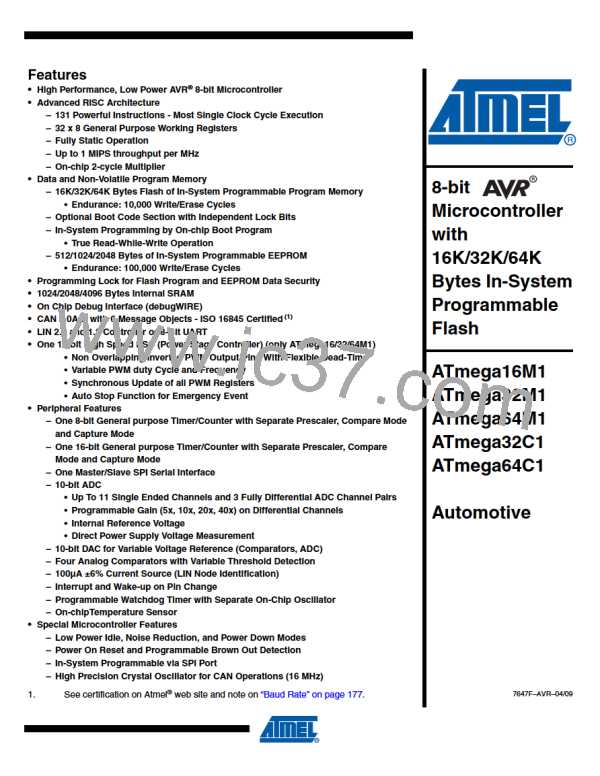ATmega16/32/64/M1/C1
15.2 SS Pin Functionality
15.2.1
Slave Mode
When the SPI is configured as a Slave, the Slave Select (SS) pin is always input. When SS is
held low, the SPI is activated, and MISO becomes an output if configured so by the user. All
other pins are inputs. When SS is driven high, all pins are inputs, and the SPI is passive, which
means that it will not receive incoming data. Note that the SPI logic will be reset once the SS pin
is driven high.
The SS pin is useful for packet/byte synchronization to keep the slave bit counter synchronous
with the master clock generator. When the SS pin is driven high, the SPI slave will immediately
reset the send and receive logic, and drop any partially received data in the Shift Register.
15.2.2
Master Mode
When the SPI is configured as a Master (MSTR in SPCR is set), the user can determine the
direction of the SS pin.
If SS is configured as an output, the pin is a general output pin which does not affect the SPI
system. Typically, the pin will be driving the SS pin of the SPI Slave.
If SS is configured as an input, it must be held high to ensure Master SPI operation. If the SS pin
is driven low by peripheral circuitry when the SPI is configured as a Master with the SS pin
defined as an input, the SPI system interprets this as another master selecting the SPI as a
slave and starting to send data to it. To avoid bus contention, the SPI system takes the following
actions:
1. The MSTR bit in SPCR is cleared and the SPI system becomes a Slave. As a result of
the SPI becoming a Slave, the MOSI and SCK pins become inputs.
2. The SPIF flag in SPSR is set, and if the SPI interrupt is enabled, and the I-bit in SREG
is set, the interrupt routine will be executed.
Thus, when interrupt-driven SPI transmission is used in Master mode, and there exists a possi-
bility that SS is driven low, the interrupt should always check that the MSTR bit is still set. If the
MSTR bit has been cleared by a slave select, it must be set by the user to re-enable SPI Master
mode.
15.2.3
MCU Control Register – MCUCR
Bit
7
SPIPS
R/W
0
6
–
5
–
4
3
–
2
–
1
IVSEL
R/W
0
0
IVCE
R/W
0
PUD
R/W
0
MCUCR
Read/Write
Initial Value
R
0
R
0
R
0
R
0
• Bit 7– SPIPS: SPI Pin Redirection
Thanks to SPIPS (SPI Pin Select) in MCUCR Sfr, SPI pins can be redirected.
• When the SPIPS bit is written to zero, the SPI signals are directed on pins MISO,MOSI, SCK
and SS.
• When the SPIPS bit is written to one,the SPI signals are directed on alternate SPI pins,
MISO_A, MOSI_A, SCK_A and SS_A.
Note that programming port are always located on alternate SPI port.
163
7647F–AVR–04/09

 ATMEL [ ATMEL ]
ATMEL [ ATMEL ]